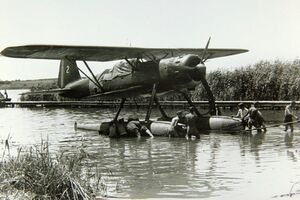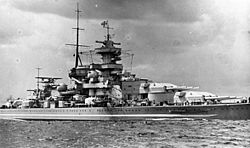Engineering:Heinkel He 114
| He 114 | |
|---|---|

| |
| Heinkel He 114 of the Romanian Air Force | |
| Role | Reconnaissance floatplane |
| National origin | Germany |
| Manufacturer | Heinkel |
| First flight | 1936 |
| Introduction | 1939 |
| Retired | 1945 (Luftwaffe) 1960 (Romania) 1949 (Sweden) 1954 (Spain) |
| Primary users | Germany Sweden Romania Spain |
The Heinkel He 114 was a sesquiwing reconnaissance seaplane produced for the Kriegsmarine in the 1930s for use from warships. It replaced the company's He 60, but did not remain in service long before being replaced in turn by the Arado Ar 196 as Germany standard observation seaplane.
Design and development
While the fuselage and flotation gear of the He 114 were completely conventional, its wing arrangement was highly unusual. The upper set of wings was attached to the fuselage with a set of cabane struts, as in a parasol wing monoplane, whereas the lower set was of much lesser span while having approximately the same chord. (Note that this general layout isn't especially unusual, and is known as a "Sesquiplane", or a biplane which has a smaller lower wing. Typically, the lower wing is about 3/4 of the span of the upper wing, and has a smaller chord as well. The He 114 has a much shorter lower wing than usual, but has the same chord as the upper wing, which keeps the wing area ratio similar.)
Operational history
The He 114 was never a great success, was not built in large numbers, and served with the Luftwaffe for only a short time. While the He 60 had handled very well on the water but been sluggish in the air, the He 114's handling while afloat was poor and its performance in the air scarcely better than the aircraft it replaced.
A total of 24 aircraft were exported to Romania, where the last 8 remained in service until 1 May 1960. In July 1943 Spain acquired a total number of 12 aircraft of the A and C variants, they were retired in 1954.
On 1 November 1939 Sweden ordered 12 aircraft of the B-1 variant, the aircraft were planned to be delivered in December the same year but was soon rescheduled to Spring the following year. In April 1940 Sweden increased the order by 24 aircraft, Heinkel responded by informing that the original order would not be delivered as the German government had enacted a ban on military materiel export to Sweden. When the ban was lifted the 12 aircraft originally intended for Sweden had already been taken into service of the Luftwaffe. By the end of 1940 Germany gave notice that it could deliver 12 aircraft, Sweden accepted but Germany soon cancelled the order. The purchase could however be realized in 1941 and 12 used He 114 arrived to Sweden dismantled in boxes in spring the same year. The airplanes were assembled and given a complete overhaul before entering service at Roslagens flygflottilj (F2) in Hägernäs under the designation S 12 (S being an abbreviation for 'reconnaissance aircraft' in Sweden).
The hilfskreuzer Atlantis, Pinguin and Widder were equipped with two He 114 each. They made extensive use of these aircraft during their raiding careers in 1940-41, until the aircraft were lost or worn out. Some were replaced by Arado's brought by supply ships whilst they were still at large.[1]
Surviving aircraft
In 2012, two divers discovered the wreckage of a Heinkel 114 at the bottom of Lake Siutghiol, in Romania. Near the Heinkel were also sections of two other seaplanes: a Savoia-Marchetti S.55 and a Junkers W 34.[2]
Variants
- He 114A-0
- 10 pre-production aircraft, powered by a 656 kW (880 hp) BMW 132Dc engine.
- He 114A-1
- Training version, powered by a 656 kW (880 hp) BMW 132Dc engine, 33 built.
- He 114A-2
- Main production shipborne version.
- He 114B-1
- Export version of the He 114A-2 for Sweden, 12 built.
- He 114B-2
- Export version of the He 114A-2 for Romania, six built.
- He 114B-3
- Export version for Romania, 12 built.
- He 114C-1
- Reconnaissance biplane for the Luftwaffe, 14 built.
- He 114C-2
- Unarmed shipborne (Kriegsmarine commerce raider) version, four built.
Operators
 Germany
Germany
- Luftwaffe
 Romania
Romania
- Royal Romanian Naval Aviation received 24 aircraft.
- Romanian Air Force operated several aircraft until 1960.
 Spain
Spain
- Spanish Air Force
- Spanish Navy
 Sweden
Sweden
Specifications (He 114A-2)
Data from Warplanes of the Luftwaffe.,[3] Heinkel: Chronik und Typenblätter der Firma Heinkel-Flugzeugbau[4]
General characteristics
- Crew: 2
- Length: 11.65 m (38 ft 3 in)
- Wingspan: 13.6 m (44 ft 7 in)
- Height: 5.23 m (17 ft 2 in)
- Wing area: 42.3 m2 (455 sq ft)
- Empty weight: 2,300 kg (5,071 lb)
- Gross weight: 3,670 kg (8,091 lb)
- Powerplant: 1 × BMW 132K 9-cylinder air-cooled radial piston engine, 716 kW (960 hp)
Performance
- Maximum speed: 335 km/h (208 mph, 181 kn)
- Range: 920 km (570 mi, 500 nmi)
- Service ceiling: 4,900 m (16,100 ft)
- Rate of climb: 5.5 m/s (1,080 ft/min) [5]
- Time to altitude: 1,000 m (3,300 ft) in 4 minutes 30 seconds
- Wing loading: 86.8 kg/m2 (17.8 lb/sq ft)
- Power/mass: 0.20 kW/kg (0.12 hp/lb)
Armament
- 1 × 7.92×57mm (.312 in) MG 15 machine gun in flexible mount for observer
- 2 × 7.92×57mm (.312 in) MG 17 machine gun behind the engine firing through the propeller arc (optional)
- 2 × 50 kg (110 lb) bombs
See also
Aircraft of comparable role, configuration and era
Related lists
- List of aircraft of World War II
- List of military aircraft of Germany
- List of seaplanes and flying boats
References
Notes
- ↑ Muggenthaler 1977, pp. 27,61,68.
- ↑ Bozîntan, Florentina (10 December 2013). "Hidroavion din Al Doilea Război Mondial, descoperit în lacul Taşaul". Cuget Liber. http://www.cugetliber.ro/stiri-eveniment-hidroavion-din-al-doilea-razboi-mondial-descoperit-in-lacul-tasaul-201060.
- ↑ Donald 1994, p.107.
- ↑ Ernst Heinkel (1996) (in de). Heinkel: Chronik und Typenblätter der Firma Heinkel-Flugzeugbau. Munich: Aviatic-Verlag. p. 98. ISBN 9783925505089.
- ↑ Smith and Kay 1972, p.268.
Bibliography
- Axworthy, Mark (September–October 1999). "Flank Guard: Romania's Advance on Stalingrad, Part Two". Air Enthusiast (65): 72–75. ISSN 0143-5450.
- Cortet, Pierre (March 2000). "Rétros du Mois" (in French). Avions: Toute l'aéronautique et son histoire (84): 7. ISSN 1243-8650.
- Donald, David, ed. Warplanes of the Luftwaffe. London: Aerospace, 1994. ISBN:1-874023-56-5.
- Muggenthaler, August K. (1977) (in de). Das waren Die Deutschen Hilfskreuzer 1939-1945. Bewaffnete Handelsschiffe im Einsatz.. Stuttgart: Motorbuch Verlag. ISBN 3-87943-261-9.
- Smith J. R. and Kay, Anthony. German Aircraft of the Second World War. London: Putnam & Company, 1972. ISBN:0-370-00024-2.
 |


